This is a combination of my presentation and workshop notes from this weekend.
CSM Ribber workshop notes
Introduction
The ribber for the CSM usually has half the slots (trix) of the cylinder it goes with - eg a 72 cylinder has a 36 ribber - although occasionally it’s possible to use a different combination. The ribber mounts on top of the cylinder (this height can be adjusted - check your manual for how to do this). It has a lug on the underside, which engages against a lug inside the main cylinder when rotated in the direction of knitting (counterclockwise). The ribber does not have a retainer spring so the needles are loose in the slots. The alignment of the ribber slots can be adjusted with a lever attached to the lug; this enables the user to create different ribs. My Imperia is set to knit on the main cylinder at T6 and the ribber at T3 - you may have to play around to see what works best for your machine.
I made some sketches of my CSM setup (ie the heights and distances) here - it's worth recording yours when you get your CSM working well, so that if anything ever starts playing up, you can check and see if anything changed.
I made some sketches of my CSM setup (ie the heights and distances) here - it's worth recording yours when you get your CSM working well, so that if anything ever starts playing up, you can check and see if anything changed.
The cylinder: Ribber dial adjuster lug highlighted in red
The ribber
This chart lists all the ribbing combinations possible with various cylinders and ribbers.
Selvedge cast on 1x1 rib
- Get some waste yarn knitting established on the machine using the cast on basket or a cast on bonnet, using every other needle in the main cylinder.
- Put the ribber on, and check its alignment so that the ribber needle slot lines up with the empty slot on the cylinder.
- Working around the cylinder in a counterclockwise direction, add a ribber needle (with latch open) into every ribber slot.
- Knit a few rounds with waste yarn and check that all needles in both cylinder and ribber are knitting off correctly.
- When you are ready to start knitting with main yarn, stop the yarn carrier so that it is at 3 o’clock and just before the hash mark.
- Break the waste yarn between the mast and the ball, and tie the main yarn onto it.
- Using your dental pick/hook tool, pull the yarn through the yarn carrier until the knot has passed through the hole, and pull a length of main yarn about 15cm (for weaving in later).
- Hold this yarn in a SW direction, towards the centre of the CSM, in such a way as to ensure it knits on the first needle past the hash mark.
- Carefully crank to 12 o’clock
- Insert a hook or latch tool up between cylinder and ribber, and pull the loose yarn and main yarn end through the gap.
- Slowly knit around to about 6 o’clock.
- As you approach 3 o'clock, set the ribber to slip, so that the first ribber needle counterclockwise of the hash mark does not knit. On my imperia, this occurs when a corner of the ribber plate almost lines up with 3 o’clock. When you find the sweet spot on your ribber, it might be worth marking it on the ribber with nail varnish.
- Slowly knit two rounds*, and slow down as you approach the 3 o’clock position again
- Put the ribber back out of slip when it reaches the same “sweet spot” as before, and set your row counter to 0.
- Crank as many rows of rib as you require.
- When changing to stocking stitch, again I like to start at 3 o’clock.
- Remove the needle retainer spring
- Starting at 3 o’clock, just past the hash mark, transfer the ribber stitch to the cylinder needle by hooking the empty needle into the ribber one. Make sure the cylinder needle latches are open (the stitch will be below the latch, that doesn’t matter).
- Continue working around the cylinder until the ribber is empty.
- Remove the ribber - don’t forget to replace the needle retainer spring!
- Continue knitting your sock or other item
- When removing the waste yarn from the ribbing, I use a sharp pointed pair of scissors to carefully cut the waste yarn every 5-6 stitches. You can then just pull it out.
Note: If you find your cast on edge is a bit loose, add the heel spring for steps 7 to 13 - the cast on row and the slipped rows.
* Two rounds is sufficient for sock yarn. You might find 1 round is sufficient for slightly thicker yarn, and perhaps 3 for a laceweight yarn. Keep an eye on the knitting and pull down on it if necessary.
Tying on (steps 6-7)
Cranked one quarter (steps 8-10)
1x1 selvedge with no heel spring added
1x1 selvedge with heel spring added
Alternate methods for ribbing

1x1 hooked up: Set up as before, but crank one round of main yarn with every other needle out of work. Add the ribber and ribber needles and use the pick tool to place the bar of yarn between cylinder needles to fill the ribber needle. Be careful not to split the yarn! You do not need to work the slip rounds after this.
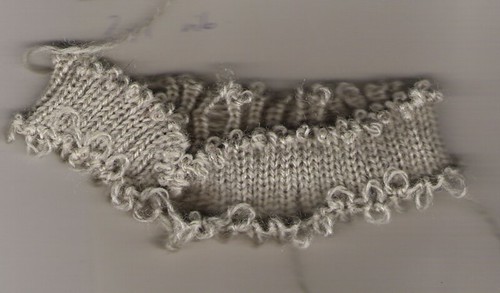
2x1 partial: The cast on edge is across the top
Found online:
2 x 1 ribbing: Set machine up for every needle in work on the cylinder, and get the knitting established on waste yarn. Transfer every 3rd needle to the ribber, crank a few rounds. Tie on main yarn as above, add heel spring, and crank one round. Put the first of every pair of cylinder needles out of work (fully up) and crank two rounds (the ribber is still working at this point). Put the raised needles back into work (with latches open), zero the row counter, remove the heel spring and off you go!
I found this produced a very loopy edge (see above), so you might try either using the heel spring or tightening the tension for the cast on rows.

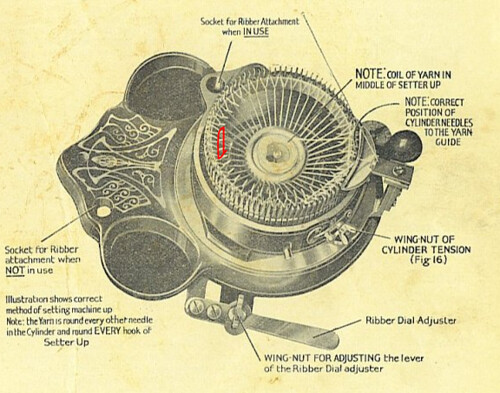
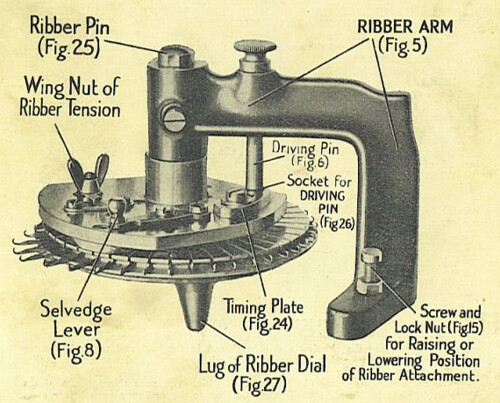


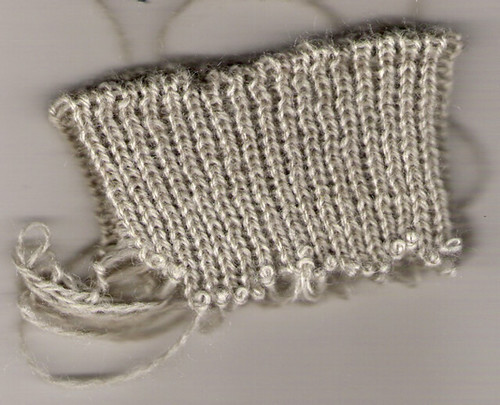

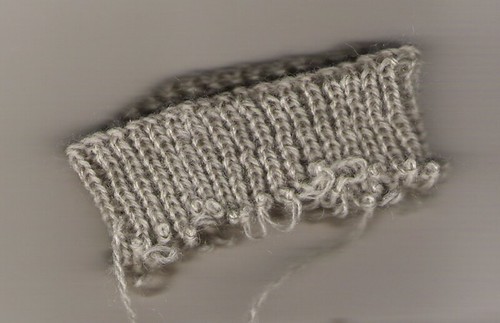
1 comment:
Very comprehensive instructions and clear photos. Will keep this in my favourites section to refer to in future.
Thanks Jane.
Post a Comment